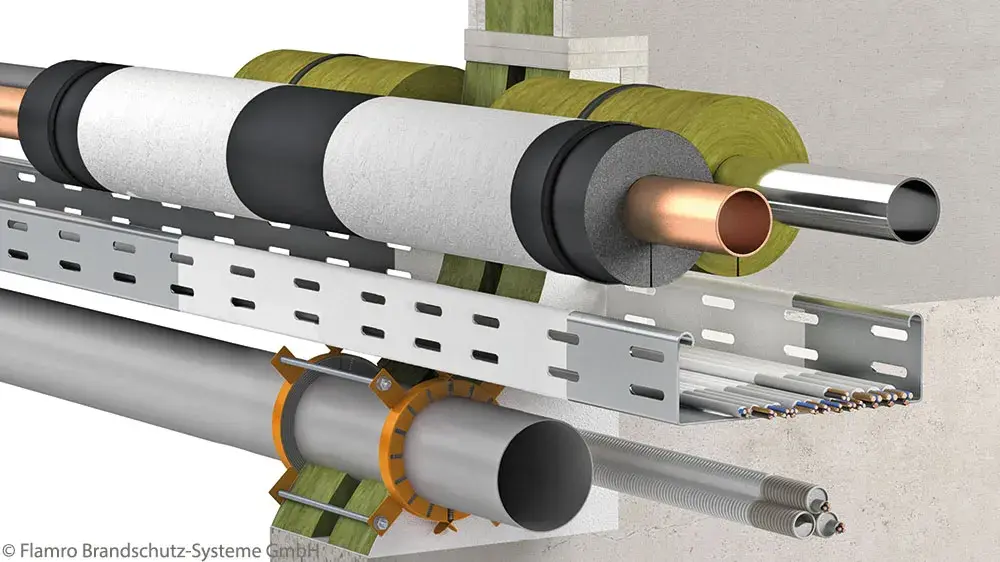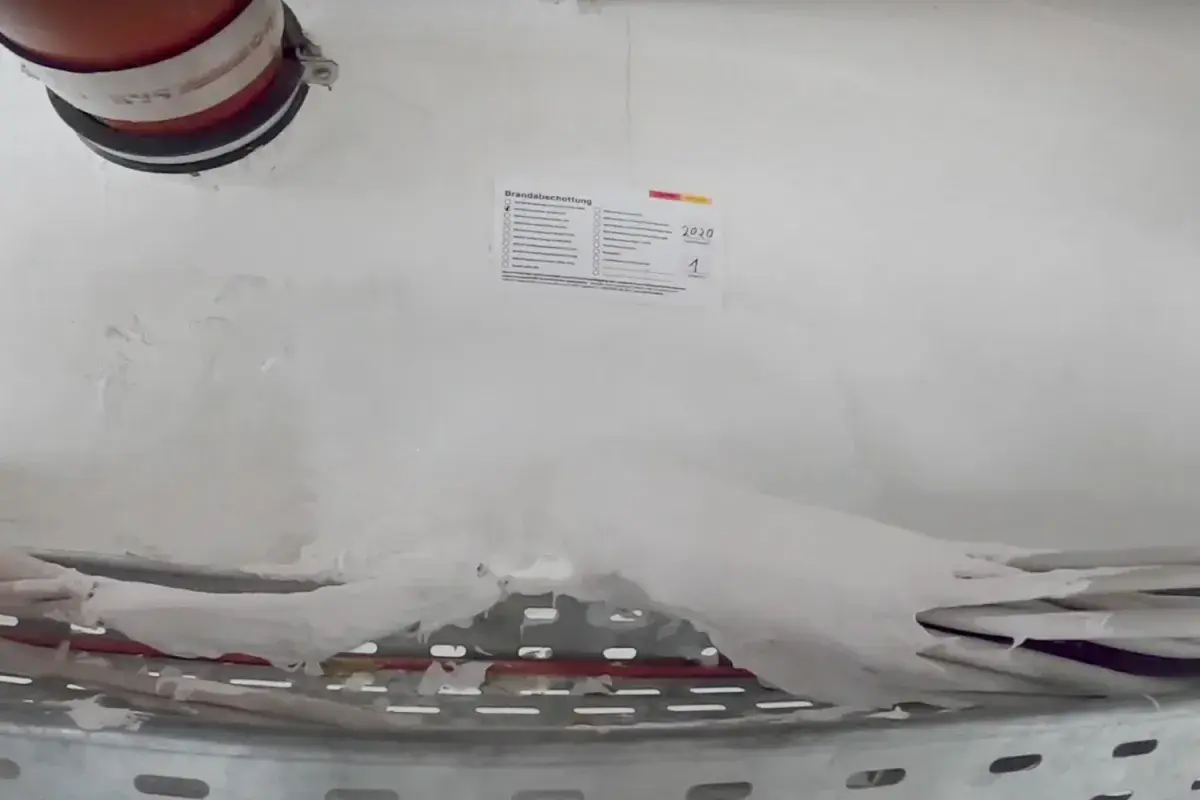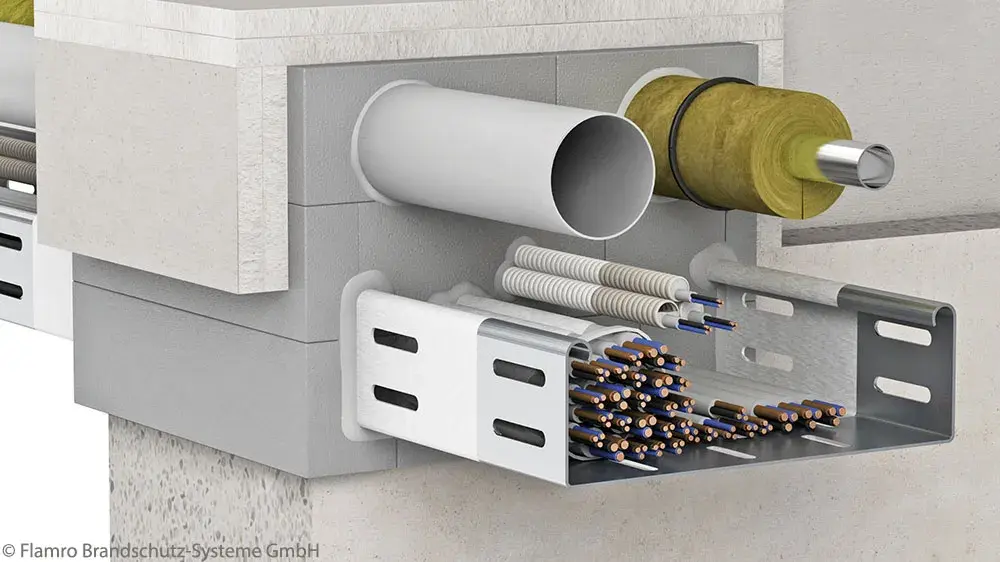Normally, buildings are divided into several fire compartments. Classified walls, ceilings and doors separate the individual fire compartments from each other. This prevents fire and smoke from spreading to other areas. The danger to people and property is reduced, and the fire department can fight the fire effectively. But you're probably familiar with this from your business: IT needs additional lines, and ventilation pipes and electrical installations also require more space. At some point, the walls forming the fire compartment are as full of holes as Swiss cheese because of the many penetrations. So-called fire barriers restore fire protection.
What is the purpose of fire partitions
Bulkhead systems are part of structural fire protection. They help seal walls, ceilings and subfloors against fire, smoke and fire gases. Fireproofing systems must match the fire resistance of the surrounding building components. For example, if a wall is fire-rated - it can withstand fire for up to 90 minutes - the bulkheading must also meet this requirement (S90, S for bulkhead, 90 for minutes).

What fire partitions are used
There is a wide range of systems. They differ in material, design and mode of operation. The most common include:
- Soft bulkheads suitable mainly for cable penetrations and non-combustible pipes. Soft bulkheads consist of mineral wool boards and a coating that swells in the event of fire.
- Mortar bulkhead suitable for cable penetrations and pipes.
- Cushion bulkhead suitable for cable penetrations. The cushions made of mineral or glass fiber are placed in the opening to be closed. They are mostly used as a temporary solution also for empty openings.
- Fire protection bandage suitable for wrapping cable support systems and cable bundles indoors.
- Fire protection collar is placed around combustible pipes.
- Fire protection foam suitable for sealing narrow annular gaps. The foam swells after installation, the opening is pressed shut.
- Cable box is a prefabricated steel sheet housing through which cables are passed through openings, ceilings and floors. The box is lined with material that foams up in case of fire and closes the interior. At the ends, the box is sealed against smoke.
How to find the right fire barrier
The choice of the right firewall depends on the installation situation in your building. The assessment of this is complex. Our experts for structural fire protection pay particular attention to the surrounding building components and their fire resistance class during the assessment. Other decisive criteria are the type of cable penetrations such as cables and pipes, their properties, and the size of the opening to be closed.

What to consider during installation
Bulkhead systems require general approval by the German Institute for Building Technology (DIBt) or a test certificate issued by the building authorities (AbZ). For fire bulkheads on electrical installations, additional specifications must be observed.
Theoretically, any craftsman may install bulkheads. When placing an order, make sure that the installers are trained in the respective system. Ask to see the relevant training certificate from the bulkhead manufacturer. CWS Fire Safety fire protection technicians are certified by all market-leading manufacturers.
Of course, we install according to the specifications of the respective manufacturer and the approval regulations. The installation instructions must be with the contractor during installation. You can convince yourself of this by taking a look at the work.
The finished fire bulkheads shall be permanently marked. The label shall contain the following information
- Manufacturer
- Year of manufacture
- Approval number
- Fire resistance class
- Name of the executing company
Forgetting the label is a classic installation mistake. Bulkhead systems without a sign will be classified as a serious defect during a fire safety inspection. For your company, however, the missing marking also has quite practical consequences, because a subsequent occupancy is likely to become almost impossible. In the absence of proof, the partitioning in question will have to be completely renewed. This is associated with considerable follow-up costs.

Why documentation is important
Beyond the mandatory labeling, additional documentation is recommended. The systems are numbered consecutively and entered in a plan. In this way, it is easy to see which fire protection system has been installed where.
This has four advantages:
- You retain an overview.
- The fire bulkheads are easy to trace during building inspections and inspections by experts.
- In the event of subsequent occupancy, for example, damaged fire bulkheads can be quickly identified by their number and repaired.
- As the client, you can verify invoicing based on the documentation. We create digital image and data documentation.
How to test fire bulkheads
We recommend a regular visual inspection of the existing bulkheads. Our experts will be happy to support you in this.
